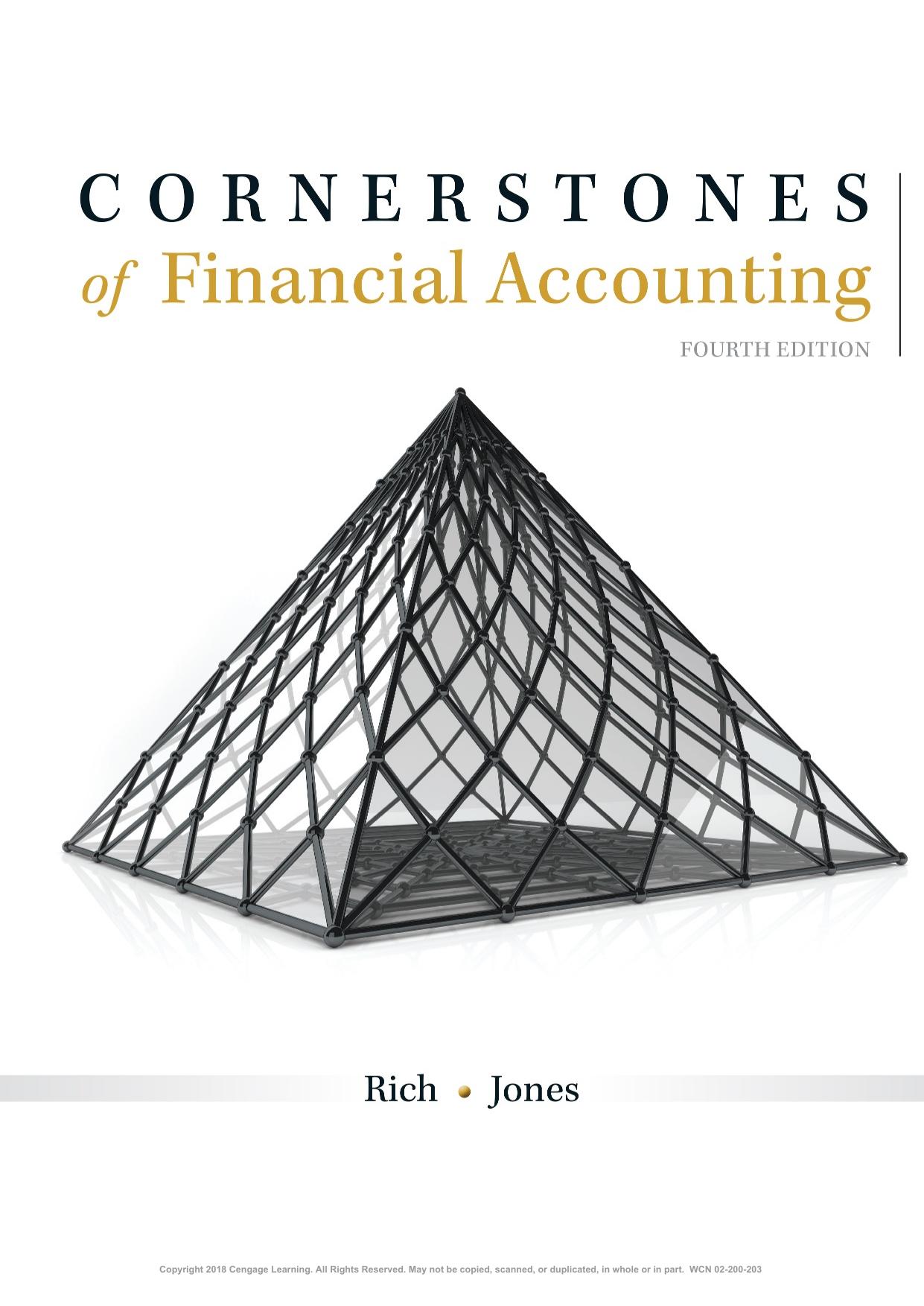Cornerstones of Financial Accounting 4th edition by Jay Rich , Jeff Jones ISBN 1337690880 978-1337690881
$70.00 Original price was: $70.00.$35.00Current price is: $35.00.
Instant download Cornerstones of Financial Accounting 4th Edition by Jay S. Rich after payment
Cornerstones of Financial Accounting 4th edition by Jay Rich, Jeff Jones- Ebook PDF Instant Download/Delivery: 1337690880, 978-1337690881
Full dowload Cornerstones of Financial Accounting 4th edition after payment
Product details:
ISBN 10:1337690880
ISBN 13:978-1337690881
Author: Jay Rich, Jeff Jones
CORNERSTONES OF FINANCIAL ACCOUNTING and CNOWv2 demonstrate the role of accounting in business with a balanced approach that highlights the relationship between accounting, financial statements, and business decisions. Built around how students like you read and use textbooks, the Cornerstones approach makes it easy to learn FASTER and MORE INDEPENTENTLY. Armed with the knowledge you gain from working through the CORNERSTONES approach, you have the tools to bring your knowledge full-circle. You practice actually making decisions based on the information that you gather and analyze.
Cornerstones of Financial Accounting 4th Table of contents:
Chapter 1. Accounting and the Financial Statements
What Is Accounting?
Businesses: Forms and Activities
Forms of Business Organization
Business Activities
Communication of Accounting Information
The Four Basic Financial Statements
The Fundamental Accounting Equation
The Classified Balance Sheet
Current Assets
Noncurrent Assets
Current Liabilities
Long-Term Liabilities and Stockholders’ Equity
Using Balance Sheet Information
The Income Statement
Elements of the Income Statement
Preparing an Income Statement
Income Statement Formats
Using Income Statement Information
Retained Earnings Statement
Use of the Retained Earnings Statement
Statement of Cash Flows
Elements of the Statement of Cash Flows
Use of the Statement of Cash Flows
Relationships Among the Statements
Other Items in the Annual Report and Professional Ethics
Notes to the Financial Statements
Management’s Discussion and Analysis
Report of Independent Accountants
Professional Ethics
Summary of Learning Objectives
Key Terms
Review Problem
Discussion Questions
Multiple-Choice Questions
Cornerstone Exercises
Brief Exercises
Exercises
Problem Set A
Problem Set B
Cases
Chapter 2. The Accounting Information System
Fundamental Accounting Concepts
The Conceptual Framework
Qualitative Characteristics of Useful Information
Assumptions
Principles
Measuring Business Activities: The Accounting Cycle
Economic Events
The Expanded Accounting Equation
Step 1: Analyze Transactions
Transaction 1: Issuing Common Stock
Transaction 2: Borrowing Cash
Transaction 3: Purchase of Equipment for Cash
Transaction 4: Purchasing Insurance
Transaction 5: Purchase of Supplies on Credit
Transaction 6: Providing Services for Cash
Transaction 7: Providing Services on Credit
Transaction 8: Receipt of Cash in Advance
Transaction 9: Payment of a Liability
Transaction 10: Collection of a Receivable
Transaction 11: Payment of Salaries
Transaction 12: Payment of Utilities
Transaction 13: Payment of a Dividend
Overview of Transactions for HiTech Communications Inc.
Double-Entry Accounting
Accounts
Debit and Credit Procedures
Step 2: Journalize Transactions
Transaction 1: Issuing Common Stock
Transaction 2: Borrowing Cash
Transaction 3: Purchase of Equipment for Cash
Transaction 4: Purchasing Insurance
Transaction 5: Purchase of Supplies on Credit
Transaction 6: Providing Services for Cash
Transaction 7: Providing Services for Credit
Transaction 8: Receipt of Cash in Advance
Transaction 9: Payment of a Liability
Transaction 10: Collection of a Receivable
Transaction 11: Payment of Salaries
Transaction 12: Payment of Utilities
Transaction 13: Payment of a Dividend
Step 3: Post to the Ledger
Step 4: Prepare a Trial Balance
Summary of Learning Objectives
Key Terms
Review Problem
Discussion Questions
Multiple-Choice Questions
Cornerstone Exercises
Brief Exercises
Exercises
Problem Set A
Problem Set B
Cases
Chapter 3. Accrual Accounting
Completing the Accounting Cycle
Accrual versus Cash Basis of Accounting
Key Elements of Accrual Accounting
Time-Period Assumption
The Revenue Recognition Principle
The Expense Recognition Principle
Applying the Principles
Accrual Accounting and Adjusting Entries
Which Transactions Require Adjustment?
Step 5: Adjusting the Accounts
Accrued Revenues
Accrued Expenses
Deferred (Unearned) Revenues
Deferred (Prepaid) Expenses
Summary of Financial Statement Effects of Adjusting Entries
Comprehensive Example
Step 6: Preparing the Financial Statements
Step 7: Closing the Accounts
Summary of the Accounting Cycle
Appendix 3A: Using a Worksheet to Prepare Financial Statements
Step 1: Unadjusted Trial Balance
Step 2: Adjusting Entry Columns
Step 3: Adjusted Trial Balance
Step 4: Income Statement
Step 5: Retained Earnings Statement
Step 6: Balance Sheet
Summary of Learning Objectives
Key Terms
Review Problem
Discussion Questions
Multiple-Choice Questions
Cornerstone Exercises
Brief Exercises
Exercises
Problem Set A
Problem Set B
Cases
Making The Connection: Integrative Exercise (Chapters 1-3)
The Accounting Cycle
Chapter 4. Internal Control and Cash
Role of Internal Control
Components of Internal Control
Control Environment and Ethical Behavior
Risk Assessment
Control Activities
Information and Communication
Monitoring
Relationship between Control Activities and the Accounting System
Accounting and Reporting Cash
Cash Controls
Reconciliation of Accounting Records to Bank Statement
Cash Over and Short
Petty Cash
Operating Cycle
Cash Management
Buying Inventory
Paying for Inventory
Selling Inventory
Short-Term Investments
Summary of Learning Objectives
Key Terms
Review Problem
Discussion Questions
Multiple-Choice Exercises
Cornerstone Exercises
Brief Exercises
Exercises
Problem Set A
Problem Set B
Cases
Chapter 5. Sales and Receivables
Timing of Revenue Recognition
Amount of Revenue Recognized
Sales Discounts
Sales Returns and Allowances
Types of Receivables
Accounting for Bad Debts
Direct Write-Off Method
Allowance Method
Bad Debts from a Management Perspective
Cash Management Principles Related to Accounts Receivable
Factoring Receivables
Credit Cards
Debit Cards
Notes Receivable
Internal Control for Sales
Analyzing Sales and Receivables
Sales
Receivables
Appendix 5A: Recording Receivables Using the Gross Method
Summary of Learning Objectives
Key Terms
Review Problem
Discussion Questions
Multiple-Choice Questions
Cornerstone Exercises
Brief Exercises
Exercises
Problem Set A
Problem Set B
Cases
Chapter 6. Cost of Goods Sold and Inventory
Nature of Inventory and Cost of Goods Sold
Types of Inventory and Flow of Costs
Cost of Goods Sold Model
Inventory Systems
Recording Inventory Transactions—Perpetual System
Accounting for Purchases of Inventory
Accounting for Sales of Inventory
Costing Inventory
Inventory Costing Methods
Specific Identification
First-In, First-Out (FIFO)
Last-In, First-Out (LIFO)
Average Cost
Analysis of Inventory Costing Methods
Illustrating Relationships: Financial Statement Effects of Alternative Costing Methods
Income Tax Effects of Alternative Costing Methods
Consistency in Application
Lower of Cost or Market Rule
Analyzing Inventory
Gross Profit Ratio
LIFO Reserve Adjustments
Effects of Inventory Errors
Appendix 6A: Periodic Inventory System
Appendix 6B: Inventory Costing Methods and the Periodic Inventory System
First-In, First-Out (FIFO)
Last-In, First-Out (LIFO)
Average Cost Method
Summary of Learning Objectives
Key Terms
Review Problem
Discussion Questions
Multiple-Choice Questions
Cornerstone Exercises
Brief Exercises
Exercises
Problem Set A
Problem Set B
Cases
Chapter 7. Operating Assets
Understanding Operating Assets
Acquisition of Property, Plant, and Equipment
Measuring the Cost of a Fixed Asset
Recording the Cost of a Fixed Asset
Depreciation
Information Required for Measuring Depreciation
Depreciation Methods
Straight-Line Method
Declining Balance Method
Units-of-Production Method
Choosing Between Depreciation Methods
Depreciation for Partial Years
Depreciation and Income Taxes
Expenditures After Acquisition
Revenue Expenditures
Capital Expenditures
Revision of Depreciation
Impairments
Disposal of Fixed Assets
Analyzing Fixed Assets
Intangible Assets
Accounting for Intangible Assets
Natural Resources
Appendix 7A: Impairment of Property, Plant, and Equipment
Summary of Learning Objectives
Key Terms
Review Problem
Discussion Questions
Multiple-Choice Questions
Cornerstone Exercises
Brief Exercises
Exercises
Problem Set A
Problem Set B
Cases
Making the Connection: Integrative Exercise (Chapters 4-7)
Integrating Asset Accounting
Chapter 8. Current and Contingent Liabilities
Current and Contingent Liabilities
Recognition and Measurement of Liabilities
Recognition of Liabilities
Measurement of Liabilities
Current Liabilities
Accounts Payable
Accrued Liabilities
Notes Payable
Current Portion of Long-Term Debt
Other Payables
Contingent Liabilities
Warranties
Analyzing Current Liabilities
People also search for Cornerstones of Financial Accounting 4th:
4 cornerstones of financial planning
cornerstones of financial accounting
financial accounting the cornerstone of business decision making
a cornerstone
cornerstones of financial accounting pdf




